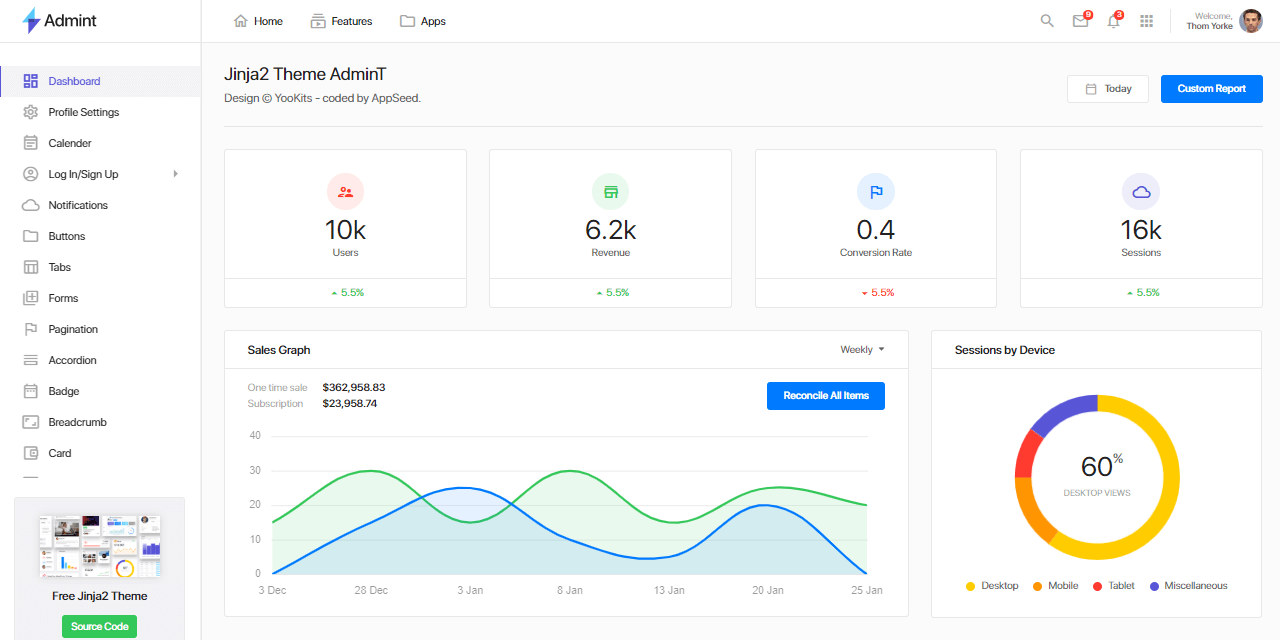Jinja2 Template Example - This document describes the syntax and semantics of the template engine and will be most useful as. In the first example, we create a very simple template. >>> import jinja2 >>> environment = jinja2.environment() >>> template = environment.from_string(hello, {{ name }}!). From jinja2 import template t = template('hello, {{ name }}!'). The most simple jinja code snippet might be the following: In the first example, we create a very simple template. >>> from jinja2 import template >>> t =. In this lesson, i’ll show you how to write a jinja2 template. Here’s a simple example of a jinja template: Through it, you can populate and render a template using variable replacement;.
AdminLTE Jinja2 Template Codementor
Here’s a simple example of a jinja template: In the first example, we create a very simple template. The most simple jinja code snippet might be the following: In the first example, we create a very simple template. >>> import jinja2 >>> environment = jinja2.environment() >>> template = environment.from_string(hello, {{ name }}!).
AdminLTE Jinja Template Codementor
In the first example, we create a very simple template. Here’s a simple example of a jinja template: From jinja2 import template t = template('hello, {{ name }}!'). In the first example, we create a very simple template. The most simple jinja code snippet might be the following:
Jinja2 Template — OpenSource and Free Medium
The most simple jinja code snippet might be the following: In the first example, we create a very simple template. This document describes the syntax and semantics of the template engine and will be most useful as. >>> from jinja2 import template >>> t =. In the first example, we create a very simple template.
Ansible Jinja2 Template Example
From jinja2 import template t = template('hello, {{ name }}!'). In this lesson, i’ll show you how to write a jinja2 template. This document describes the syntax and semantics of the template engine and will be most useful as. >>> import jinja2 >>> environment = jinja2.environment() >>> template = environment.from_string(hello, {{ name }}!). Through it, you can populate and render.
Ansible Jinja2 Templates Explained with Examples
Here’s a simple example of a jinja template: The most simple jinja code snippet might be the following: This document describes the syntax and semantics of the template engine and will be most useful as. >>> from jinja2 import template >>> t =. In the first example, we create a very simple template.
Jinja2 Template Example
Through it, you can populate and render a template using variable replacement;. In the first example, we create a very simple template. In the first example, we create a very simple template. This document describes the syntax and semantics of the template engine and will be most useful as. >>> from jinja2 import template >>> t =.
Using Jinja2 Templates in Flask Variable Expressions YouTube
In this lesson, i’ll show you how to write a jinja2 template. Through it, you can populate and render a template using variable replacement;. This document describes the syntax and semantics of the template engine and will be most useful as. In the first example, we create a very simple template. >>> import jinja2 >>> environment = jinja2.environment() >>> template.
Jinja2Example/process_template.py at master · codeselfstudy/Jinja2
Through it, you can populate and render a template using variable replacement;. This document describes the syntax and semantics of the template engine and will be most useful as. >>> from jinja2 import template >>> t =. >>> import jinja2 >>> environment = jinja2.environment() >>> template = environment.from_string(hello, {{ name }}!). From jinja2 import template t = template('hello, {{ name.
>>> import jinja2 >>> environment = jinja2.environment() >>> template = environment.from_string(hello, {{ name }}!). From jinja2 import template t = template('hello, {{ name }}!'). In the first example, we create a very simple template. In the first example, we create a very simple template. This document describes the syntax and semantics of the template engine and will be most useful as. In this lesson, i’ll show you how to write a jinja2 template. Here’s a simple example of a jinja template: Through it, you can populate and render a template using variable replacement;. >>> from jinja2 import template >>> t =. The most simple jinja code snippet might be the following:
Through It, You Can Populate And Render A Template Using Variable Replacement;.
From jinja2 import template t = template('hello, {{ name }}!'). >>> from jinja2 import template >>> t =. In this lesson, i’ll show you how to write a jinja2 template. Here’s a simple example of a jinja template:
The Most Simple Jinja Code Snippet Might Be The Following:
>>> import jinja2 >>> environment = jinja2.environment() >>> template = environment.from_string(hello, {{ name }}!). This document describes the syntax and semantics of the template engine and will be most useful as. In the first example, we create a very simple template. In the first example, we create a very simple template.






